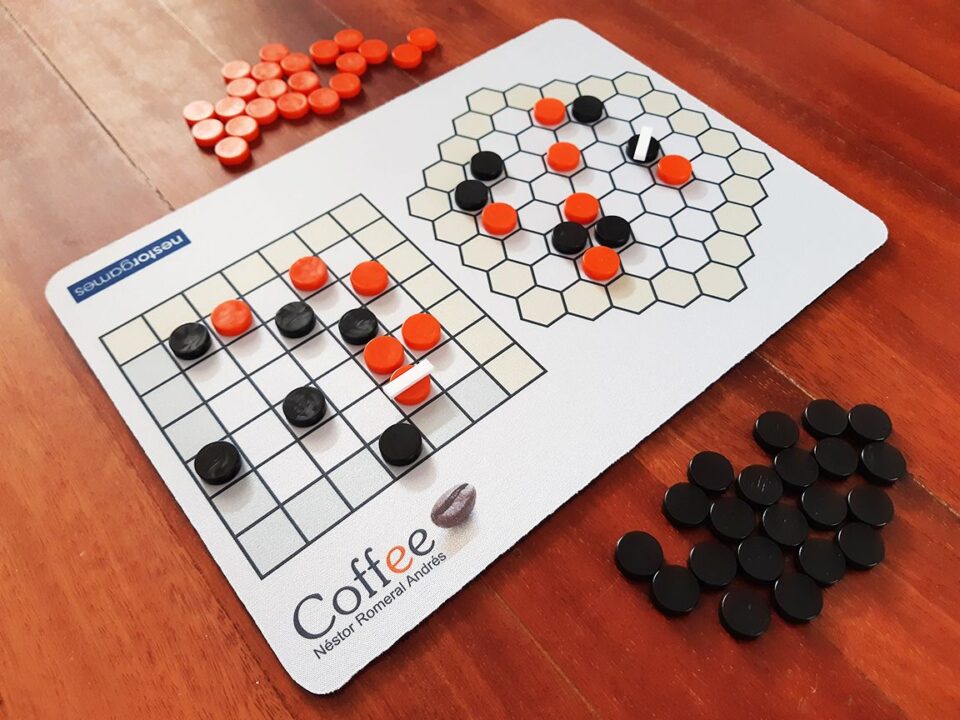You ever wondered what would happen if you mixed your love of board games with your desperate need for caffeine? Well, you’re in luck! This is my review of the board game Coffee. My friends and I played it so much, we started calling each other “Barista” and demanding tips for every move. Buckle up for a ride through my honest (and slightly jittery) thoughts—I’ll tell you what works, what falters, and if this game is worth your mug space.
How It Plays
Setting up
First, plop the board in the middle. Everyone grabs a player mat (sadly not a real coffee mat) and picks their favorite color meeples. Shuffle the bean cards and deal everyone a starting hand. Put resource tokens and café customer tiles close by. No need to grind any actual beans.
Gameplay
On your turn, you choose an action: harvest beans, roast them, or serve coffee to thirsty customers. There’s a bit of strategic planning and a pinch of sabotage—my friend Dave tried to steal my best roast, but karma got him with a burnt batch next turn. Players collect resources, manage their roasting level, and race to fulfill café orders. Watch out, though: if you focus too much on espresso, your drip coffee fans may revolt!
Winning the game
The game ends when someone finishes their fourth café order or the bean cards run out—whichever comes first. Everyone counts up points from fulfilled orders, bonus tokens, and left-over resources. The winner is crowned Supreme Barista of the Universe. No actual crown awarded, much to my disappointment.
Want to know more? Read our extensive strategy guide for Coffee.
How Coffee’s Theme and Artwork Brew Up the Fun
Let’s talk about the most important part of any board game for caffeine lovers: Coffee! I mean, that’s the actual theme here, not just my energy source while playing. Coffee drips through every piece of this game, from the aroma of the cards (okay, not actual smell, but wouldn’t that be great?) to the little wooden coffee beans that look good enough to eat. Trust me, my friend Dave tried. Don’t be like Dave.
The theme oozes personality. You’re not just moving pieces. You’re running your own bustling coffee shop. Latte art contests, bean sourcing, hipster customers who want their espresso at exactly 67°C with oat milk—this game throws you into the deep end of hipster-ville. The designers clearly love coffee. There are even little jokes on the order cards, like “Bean Me Up, Scotty” or “Grounds for Divorce.” I nearly spit my real coffee out laughing at those. My friends rolled their eyes, but I know deep down they loved it.
Artwork-wise, Coffee is a treat. Each card is bright and inviting, yet not too busy. The artists use cozy colors that make you feel like you’re in a real café. I wish my actual kitchen looked as stylish as the game board. It makes me want to put on a beanie and start listening to lo-fi music.
Basically, if you don’t like coffee, you’ll at least love how this game looks on your table. Next up, let’s see if the mechanics are as smooth as a perfectly pulled espresso shot, or if they leave a bitter aftertaste in the balance department!
Game Mechanics and Balance in Coffee: Brewing the Perfect Game Night
If you think mixing beans and hot water is the only skill you need, Coffee the board game will wake you up fast. The main mechanic is set collection, but with a twist—players race to roast, grind, and brew coffee orders using different action cards. It feels a bit like a frantic barista showdown. There’s a cool resource management element too; you need the right blend of beans, milk, sugar, and, of course, time. If you ever tried to juggle three coffee orders while your cat attacks your feet, you’ll feel right at home.
I’ll admit, I was worried the game would come down to sheer luck, but Coffee avoids that pitfall for the most part. Yes, there are random elements—drawing order cards or refilling ingredients can sometimes leave you muttering, “Why do I only get decaf?” But smart play always wins over luck. If you don’t plan ahead or watch your opponents closely, you’ll be left with spilled milk (not literally, unless you game with toddlers).
The balance here feels impressive, especially with three or four players. No one gets to steamroll the others with a lucky draw, and the scoring keeps things close. There’s a tension between taking quick, risky actions and building up a big brew, and neither strategy dominates. Even my friend Greg, who once turned Monopoly into a blood sport, couldn’t find a broken strategy.
Next, I’ll spill the beans on how Coffee gets everyone at the table buzzing—or, sometimes, snoozing—when it comes to player interaction and engagement!
Brewing Up Fun: Player Interaction and Engagement in Coffee
If you think Coffee is just about sipping pretend espresso and moving wooden beans, you’re in for a surprise! This game stirs the pot with some great player interaction. From my first play with friends, I noticed all the wheeling and dealing over those coffee contracts. You can’t just coast along; you need to watch what the other baristas are up to. If you ignore them, you’ll see your dreams of being the king of caffeine go up in steam!
What really perks me up is the action selection. Every player chooses actions at the same time, causing a rush to snatch the best beans and complete contracts. Sometimes, I saw my buddy’s plan crumble like an overbaked biscotti because I grabbed the last Robusta bean. I actually felt a little bad… for about five seconds.
The game also throws in some friendly sabotage. You can block opponents from markets or beat them to the best coffee shops. This leads to a lot of groaning, laughing, and mock accusations of bean thievery. It’s the perfect game for players who love a bit of light mischief with their strategy.
By the final rounds, everyone’s carefully watching each other’s moves, desperate to fulfill those last contracts. The tension keeps the group buzzing and no one ever zones out—unless they actually drank too much real coffee. Up next, I’ll spill the beans on replay value and whether Coffee keeps you coming back for another cup or just leaves you jittery for nothing!
How Many Cups? Replay Value and Game Length in Coffee
If you ask my friends, they’ll say I never turn down a second cup—of coffee or board games. The big question with Coffee is, does it go cold after the first play, or does it keep you coming back for that extra shot?
First off, the replay value is actually pretty strong. Every session, the order in which coffee beans, machines, and special blends show up shifts the mood. Some games feel as smooth as a latte, while others brew up chaos like an espresso on a bumpy train ride. The special barista powers mean folks tend to try out new strategies—well, except for Steve, who only wants to build the world’s slowest French Press every time. But variety is there, and it’s fun to see how different combos play out.
Now let’s talk length. This is not a marathon game destined to end friendships (looking at you, Monopoly). We clocked most of our games at about 45 minutes to an hour, which feels just right. There’s enough time for a few silly coffee puns and a little trash talk, but not enough to get a caffeine headache. Even with four players and lots of laughing, it never dragged.
So, do I recommend Coffee? If you like games that perk up your table without overstaying their welcome, this one is worth brewing up. It won’t keep you awake all night, but it sure makes for a pleasant afternoon pick-me-up.
Conclusion
I had a blast with Coffee, and not just because I drank three cups while playing it. The game nails the café vibe with quirky art and clever puns, and it doesn’t drag on like that one friend’s monologue about pour-over brewing. It’s balanced, has just the right mix of strategy and light-hearted chaos, and is easy to teach (even when you’re half-caffeinated). If you want deep, brain-burning tactics, maybe look elsewhere, but for a fun, social experience with enough replay value to keep coming back, Coffee is worth your shelf space. Unless you really hate decaf—or fair competition.
That’s all for this review. Now if you’ll excuse me, I need another espresso and a rematch.


